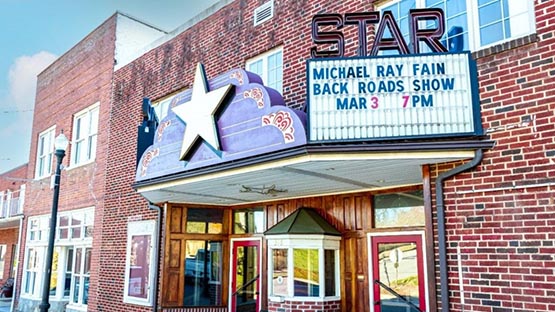
A group of graduate students at Virginia Tech have been researching the dynamics of Stuart, Va., to explore whether the investment in the 1940s Star Theatre as an anchor institution would liven up the town’s historic district.
The downtown district sits at the bottom of a hill with the courthouse and other businesses nearby. But on weekends, the streets are quiet. If you want to listen to live music, watch a play or see a movie, your options are limited.
Patrick County residents looking for a night out travel an hour or more to Floyd or Rocky Mount for entertainment.
Stuart Town Manager Bryce Simmons thinks the old theater might be the economic spark needed in the town of 1,400.
“There’s no attraction here,” said Simmons, who earned a bachelor’s degree in civil engineering in 2007 from VT. “We have gorgeous views you can’t purchase, but we lack an anchor institution to bring people into town, walk the streets, spend money, and get something to eat. I think every town needs that to be sustainable.”
Simmons turned to his alma mater to help the town make a decision.
Reynolds Homestead has served as an engagement center in the region for more than 50 years.
“They are without a doubt the one organization that is able to connect our region to the university’s resources,” Simmons said. “A lot of times, it’s difficult for a manager of a small town to approach a large institution like Virginia Tech and know where to go and who to talk to. The Reynolds Homestead makes it much easier to wade through that system and find the experts you need.”
Reynolds Homestead Director Julie Walters Steele connected Simmons to Sarah Lyon-Hill of the Center for Economic and Community Engagement to discuss the town’s plans, including the theater.
“Historic theaters can have a significant impact on small towns, providing a focal point for community activity, driving economic growth, preserving local history, and creating jobs,” said Lyon-Hill, CECE’s associate director for research development. “But a study that examines the market and the likelihood of success can provide more clarity on the effect a historic theater might have on a particular town.”
Lyon-Hill knew she had the perfect team for the job — CECE’s five graduate assistants, all of whom have been working with the center for a year.
“The great thing about this project is that it’s grad student led, it’s grad student managed, and it’s grad student operated,” said William Ferris, a doctoral candidate through the Department of Agricultural and Applied Economics in the College of Agriculture and Life Sciences. “CECE gives us a great chance to spread our wings. It’s very rewarding that CECE trusts us to operate on our own and apply our expertise to achieve tangible results.”
Along with Ferris, the team also included School of Public and International Affairs students Allison Ulaky, Kit Friedman, and Jason Schwartz — all master’s candidates in urban and regional planning — and Hye-Jeong Seo, a doctoral candidate in planning, governance, and globalization and a fellow in the Interfaces of Global Change Program.
Ferris and Friedman toured the old theater and talked to local business owners. Ulaky, meanwhile, developed and managed surveys and other engagement remotely while Schwartz and Seo researched and crunched the data.
“There is a real sense of community in Stuart. The people in that area really seem to care about what’s going on in their backyards and were very vocal about what they’d like to see and how the theater would impact their lives,” Ulaky said.
Simmons said a survey they distributed was incredibly effective.
“The data they found verified the information I thought I already knew,” he said. “It’s one thing for the town manager to go in front of council and say, ‘These are the numbers and this is the information I believe to be true.’ But then to be able to have a third party come in and evaluate the situation and say, ‘Yes, you’re right. These numbers match up’ – that gives me a podium to stand on to say that we are moving in the right direction.”
For Schwartz, having that kind of impact on the outcome of a project makes the work meaningful.
“It’s more than academic work. It’s the real world, so nothing is black-and-white,” he said. “That’s the greatest benefit. No one is grading us, but our work is going to have impact.”
If Simmons’ plan gets the town council’s approval, the Star Theatre would add one more venue to the historic district.
A Reynolds Homestead program that brings creative and business-minded entrepreneurs together has shepherded the establishment of two other businesses just steps from the old theater – the Rise and Shine Market and Calliope: A Circus of the Arts. Both businesses promote local artists. The market provides a place for emerging artists to sell their work, while Calliope also provides retail space as well as room for arts studios and classes for all ages.
“A creative economy can help retain a talented and diverse workforce, promote entrepreneurship and innovation, and create unique cultural experiences that draw in visitors and residents alike,” said Walters Steele.
Simmons said he’d love to see the area become Stuart’s arts district.
“To do your regular business you go uptown. But then when you’re ready to have a little bit of fun, you go downtown,” he said.










